Two-particle correlations in high-energy collision experiments enable the extraction of particle source radii by using the Bose-Einstein enhancement of pion production at low relative momentum $q\propto 1/R$. It was previously observed that in $\rm{p}\rm{p}$ collisions at $\sqrt{s}=7$ TeV the average pair transverse momentum $k_{\rm T}$ range of such analyses is limited due to large background correlations which were attributed to mini-jet phenomena. To investigate this further, an event-shape dependent analysis of Bose-Einstein correlations for pion pairs is performed in this work. By categorizing the events by their transverse sphericity $S_{\rm T}$ into spherical $(S_\textrm{T}>0.7)$ and jet-like $(S_\textrm{T}<~0.3)$ events a method was developed that allows for the determination of source radii for much larger values of $k_{\rm T}$ for the first time. Spherical events demonstrate little or no background correlations while jet-like events are dominated by them. This observation agrees with the hypothesis of a mini-jet origin of the non-femtoscopic background correlations and gives new insight into the physics interpretation of the $k_{\rm T}$ dependence of the radii. The emission source size in spherical events shows a substantially diminished $k_{\rm T}$ dependence, while jet-like events show indications of a negative trend with respect to $k_{\rm T}$ in the highest multiplicity events. Regarding the emission source shape, the correlation functions for both event sphericity classes show good agreement with an exponential shape, rather than a Gaussian one.
JHEP09 (2019) 108
HEP Data
e-Print: arXiv:1901.05518 | PDF | inSPIRE




